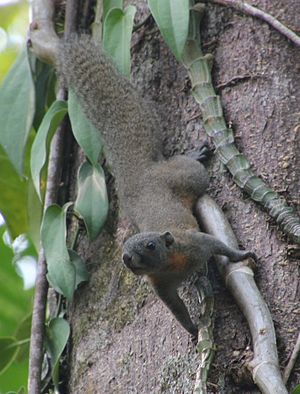Ponytail squirrel
| Ponytail squirrel | ||||||||||||
|---|---|---|---|---|---|---|---|---|---|---|---|---|

Ponytail squirrel ( Sundasciurus hippurus ) |
||||||||||||
| Systematics | ||||||||||||
|
||||||||||||
| Scientific name | ||||||||||||
| Sundasciurus hippurus | ||||||||||||
| ( I. Geoffroy Saint-Hilaire , 1831) |
The ponytail squirrel ( Sundasciurus hippurus ) is a species of squirrel from the genus of the Sunda tree squirrel ( Sundasciurus ). It is common in Southeast Asia from Thailand to Malaysia as well as Sumatra and Borneo.
features
The ponytail squirrel reaches a head-torso length of about 23.4 to 24.7 centimeters with a weight of about 360 to 435 grams. The tail is 23.0 to 24.6 inches long, about the same length as the rest of the body. The back color of the animals is gray-black to brown. The animals of the Malay mainland are rather dark chestnut brown, the sides of the body are mottled gray-black and the belly is brick-red. In individuals on Borneo, the head and shoulders are rather gray and the belly side is reddish brown. The tail is very thick and bushy, it is glossy black-brown to black in color.
distribution
The ponytail squirrel is found in Southeast Asia on the Malay Peninsula (in southern Thailand and mainland Malaysia ) and on the islands of Sumatra and Borneo . In Borneo, the species lives on the entire island and can accordingly be found in the Malay states of Sarawak and Sabah , in the Sultanate of Brunei and in the Indonesian Kalimantan . The altitude distribution ranges from the lowlands to the middle altitudes. At Gunung Tahan the species was detected at altitudes of just over 1000 meters, and at Mount Dulit in Sarawak up to over 1500 meters.
Way of life
The ponytail squirrel lives mainly in primary forests in the lowlands, but can also be found in smaller numbers in high secondary forests . It lives mainly in the undergrowth and in smaller trees as well as near the ground or on the ground. As a rule, the animals are solitary or they live in pairs. They are diurnal and feed on plant seeds, fruits and insects. Communication takes place via calls that are described as "chek ... chek ... chekchekchekchek ...".
Systematics
The ponytail squirrel is classified as an independent species within the genus of the Sunda tree squirrel ( Sundasciurus ), which - depending on the author - consists of 15 to 17 species. The first scientific description comes from Isidore Geoffroy Saint-Hilaire from 1831, who described the species on the basis of individuals with the indication of origin "Java Island". The terra typica was subsequently limited to Malacca , Malaysia.
Together with the nominate form, five to seven subspecies are distinguished within the species :
- Sundasciurus hippurus hippurus : nominate form, the exact delimitation of the distribution is not known, it occurs in all areas of the distribution area.
- Sundasciurus hippurus borneensis in the Indonesian Kalimantan on Borneo, in areas where the nominate form is missing. The ventral side is brick red and it is very gray on the shoulders and hips. The tail is completely dark, thick, and bushy.
- Sundasciurus hippurus hippurellus in coastal regions of Borneo, in the west of Kalimantan and along the Kapuas and Landak rivers in Sarawak and on the lower Rejang . The ventral side is dark red, the tail is dark and thick and bushy, sometimes with a red tip.
- Sundasciurus hippurus hippurosus on the west coast of Sumatra, a large form.
- Sundasciurus hippurus inquinatus on Borneo from Lawas to the Sebuku and Sembakung rivers in northeast Kalimantan. The ventral side is cloudy orange.
- Sundasciurus hippurus pryeri in the Sabah lowlands. The ventral side is white with a red wash in some individuals. The tail is grayish.
Thorington et al. 2012 also describes the subspecies Sundasciurus hippurus ornatus from Cà Mau from the southern tip of Vietnam - but this is outside the range described by Thorington himself.
Status, threat and protection
The ponytail squirrel is relatively common in some areas. In surveys on the Malay Peninsula in the area of the Weng River, it was the second most common species of the genus with a density of about 4 individuals per square kilometer. In the Danum Valley in Sabah, almost 20 individuals per square kilometer were found, in Nanga Gaat in Sarawak it is only 2.5 on average.
The species is classified by the International Union for Conservation of Nature and Natural Resources (IUCN) in the early warning list (Near Threatened). This classification is justified with the increasing loss of habitat in large parts of the distribution area and the associated decline in populations. The main threat to the species comes from logging on the islands.
supporting documents
- ↑ a b c d e f g Richard W. Thorington Jr., John L. Koprowski, Michael A. Steele: Squirrels of the World. Johns Hopkins University Press, Baltimore MD 2012; Pp. 184-185. ISBN 978-1-4214-0469-1
- ↑ a b c Sundasciurus hippurus In: Don E. Wilson , DeeAnn M. Reeder (Ed.): Mammal Species of the World. A taxonomic and geographic Reference. 2 volumes. 3. Edition. Johns Hopkins University Press, Baltimore MD 2005, ISBN 0-8018-8221-4 .
- ↑ a b c d Sundasciurus hippurus in the IUCN Red List of Threatened Species 2014.3. Posted by: C. Francis, E. Meijaard, KH Han, 2008. Retrieved January 2, 2015.
literature
- Richard W. Thorington Jr., John L. Koprowski, Michael A. Steele: Squirrels of the World. Johns Hopkins University Press, Baltimore MD 2012; Pp. 184-185. ISBN 978-1-4214-0469-1
Web links
- Sundasciurus hippurus inthe IUCN Red List of Threatened Species 2014.3. Posted by: C. Francis, E. Meijaard, KH Han, 2008. Retrieved January 2, 2015.